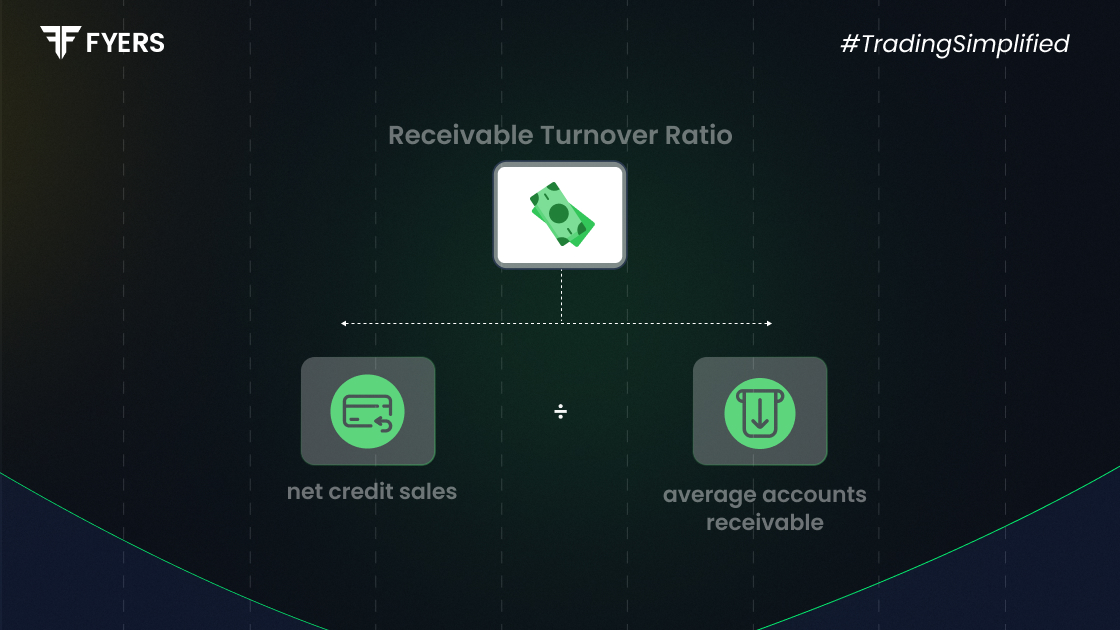

 30 Jul, 2025
30 Jul, 2025
 5 mins read
5 mins read

Managing cash flow efficiently is crucial for any business. One important tool for assessing how quickly a company collects payments from its customers is the receivables turnover ratio. This financial ratio reflects how well a business converts credit sales into cash, which is vital for operations and financial stability.
The accounts receivable turnover ratio tells us how many times, on average, a business collects its outstanding credit over a period, usually a year. It indicates how efficiently a company manages the credit it extends to customers.
Put simply, the receivables turnover ratio shows how fast a company receives payments from customers who purchased goods or services on credit. A higher ratio suggests that the business is efficient at collecting money and customers are paying promptly. A lower ratio may indicate slow collections, relaxed credit terms, or poor follow-up.
Understanding what is accounts receivable turnover helps in evaluating a firm’s credit policy and the strength of its internal controls related to billing and collection.
To assess the effectiveness of receivables collection, you need to know how to calculate receivables turnover. The formula is:
|
Receivables Turnover Ratio = Net Credit Sales ÷ Average Accounts Receivable |
Net Credit Sales: Total credit sales after subtracting any returns or allowances.
Average Accounts Receivable: (Opening Receivables + Closing Receivables) ÷ 2
Example:
Assume a company has net credit sales of ₹50,00,000. If its opening receivables were ₹4,00,000 and closing receivables were ₹6,00,000:
Average Receivables = (₹4,00,000 + ₹6,00,000) ÷ 2 = ₹5,00,000
Receivables Turnover Ratio = ₹50,00,000 ÷ ₹5,00,000 = 10
Receivables Turnover in Days = 365 ÷ 10 = 36.5
This means the business collects its receivables approximately every 36 days, which can be compared to industry standards to judge performance.
A healthy accounts receivable turnover ratio indicates efficient management, but there is always room for improvement. Here are some effective ways to strengthen this ratio:
Reduce credit periods: Offer shorter payment timelines to customers.
Send invoices quickly: Faster invoicing leads to faster collections.
Offer early payment incentives: Discounts can encourage quicker payments.
Follow up regularly: Timely reminders keep customers on track.
Check customer creditworthiness: Avoid extending credit to unreliable clients.
Use accounting software: These tools help track receivables and set alerts.
Segment customers: Apply tailored payment terms based on each customer’s history.
Automate reminders: Set up emails or SMS alerts near due dates.
Knowing how to improve accounts receivable turnover ratio is essential for sustaining positive cash flow and ensuring steady operations.
Monitoring this ratio regularly brings several operational and financial benefits:
Stronger cash flow: Regular collections provide liquidity for daily needs.
Identify slow-paying clients: Adjust terms or follow-up processes as needed.
Boost internal efficiency: A higher ratio reflects tight control over receivables.
Attract investors and lenders: Financial stakeholders prefer companies with predictable inflows.
Early warning signs: A declining ratio might signal trouble with customer payments or credit policies.
Informed decision-making: Enables business owners to align credit policies with strategic goals.
By understanding receivables turnover ratio and keeping it in check, businesses can avoid working capital shortfalls and maintain financial discipline.
Let us consider a practical receivables turnover ratio example to illustrate its use in real scenarios.
Example 1: ABC Pvt Ltd.
Net Credit Sales: ₹60,00,000
Opening Receivables: ₹10,00,000
Closing Receivables: ₹5,00,000
Average Receivables: (₹10,00,000 + ₹5,00,000) ÷ 2 = ₹7,50,000
Receivables Turnover Ratio = ₹60,00,000 ÷ ₹7,50,000 = 8
Receivables Turnover in Days = 365 ÷ 8 = 45.6
This indicates that ABC collects payments roughly every 46 days. If the industry average is 60 days, ABC is managing credit well.
Example 2: XYZ Ltd.
Net Credit Sales: ₹80,00,000
Average Receivables: ₹20,00,000
Receivables Turnover Ratio = ₹80,00,000 ÷ ₹20,00,000 = 4
Receivables Turnover in Days = 365 ÷ 4 = 91.3
Here, XYZ takes about 91 days to collect its dues, indicating a weak collection process or liberal credit policy.
These examples underline how companies with higher turnover ratios can better manage cash flow and business stability.
Although this ratio is helpful, it has its limitations:
Excludes cash sales: It only covers credit sales and collections.
Industry differences: Terms and collection periods vary across sectors.
Seasonal effects: Sales and collections may fluctuate during certain times of the year.
Customer variability: Not all clients receive the same payment terms.
Irregular payments: One-off or lump sum payments may distort the ratio.
Because of these constraints, it is wise to use the receivables turnover ratio alongside other financial metrics and industry comparisons.
The receivables turnover ratio offers valuable insight into a company’s credit and collection efficiency. It reveals whether a business is converting credit sales into cash quickly, which is critical for maintaining liquidity and financial health.
Understanding what accounts receivable turnover is, how to calculate receivables turnover, and analysing receivables turnover ratio examples help businesses strengthen their credit policies. A high ratio usually signals effective collections, while a low one suggests a need to reassess credit terms or follow-up efforts.
To keep the ratio healthy, businesses should invoice promptly, assess customer reliability, offer payment incentives, and use accounting tools.
It shows how often a company collects money from customers who bought on credit.
It means the business collects payments quickly and manages credit well.
It suggests payments are slow or the business is not collecting money efficiently.
Not always. A very high ratio may mean the company is too strict with credit and could be losing potential sales.
Yes, credit periods vary across industries, so comparisons should be made within the same sector.
Calculate your Net P&L after deducting all the charges like Tax, Brokerage, etc.
Find your required margin.
Calculate the average price you paid for a stock and determine your total cost.
Estimate your investment growth. Calculate potential returns on one-time investments.
Forecast your investment returns. Understand potential growth with regular contributions.